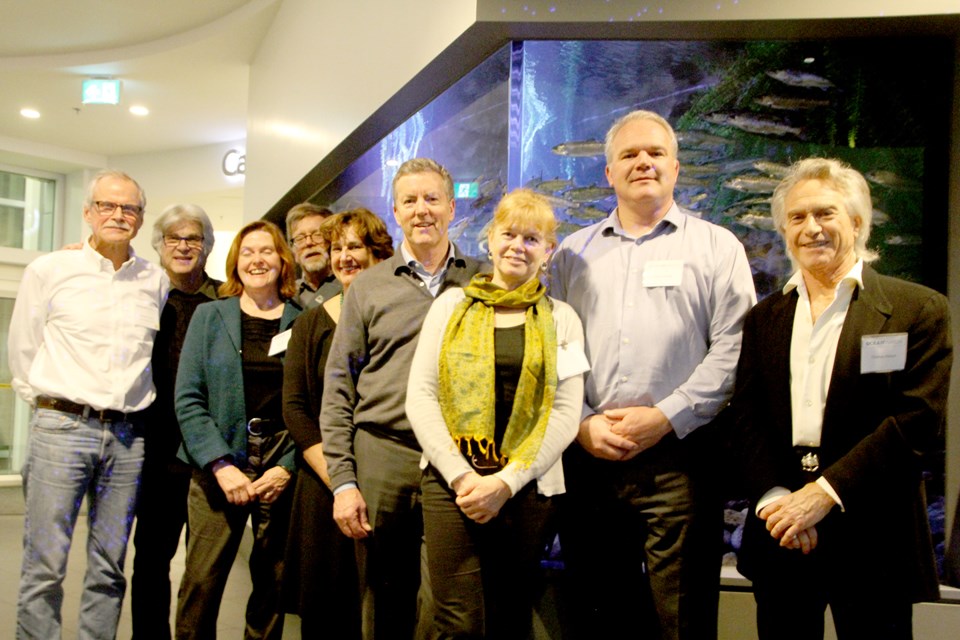An attempt to measure the health of Howe Sound has brought together scientific, indigenous and historical perspectives, and also, the contributions of almost a dozen Bowen Islanders. At a launch last week at the Vancouver Aquarium, Andrew Day, the Executive and Vice President of the Coast Ocean Research Institute, said the Ocean Watch Howe Sound report reflects “the great thinning of life” we are all living through, but also the beginning of action to protect the region.
The 364 page report covers everything from the state of forage fish, to water quality, stewardship efforts and development pressures.
Day asked the audience at the launch to consider connections between the subjects, pointing to the chapter on plankton, noting that if there is silt in the water (usually caused by development and industrial activities) the sunlight is blocked and the plankton can not bloom.
“Without plankton, there is nothing for the salmon to eat. Without salmon, there’s no food for whales,” said Day.
He pointed to the return of whales to the Sound as a victory, and noted that 2015 had the greatest number of sightings reported since the early 2000s.
“Even though we are seeing the recovery of whales, we are only seeing a fraction of what has been here,” he said, going on to explain that Howe Sound was once home to 80 Humpbacks, all of which were killed by a commercial whalers in one year.
On sea stars, he said that while some species are showing a recovery after being decimated a few years ago there are 20 species that show no signs of recovery at all.
Day pointed to Monterrey Bay, California, as a model for hope. The Bay experienced a significant recovery due in part to the commitment of many individuals determined to make it happen.
“We have also discovered that Howe Sound has such a wealth of citizen scientists, volunteers and governments committed to recovery,” said Day, noting the Federal Government’s recent $1.5 billion commitment to ocean health and science.
Bob Turner, former Bowen Island mayor and one of the leads on this report, says that Monterrey Bay does serve as a good example for exceptional recovery.
“It doesn’t have the same kind of industrial history we do here in Howe Sound. Monterrey Bay had canneries, so they don’t have this history of water contamination,” says Turner. “It is a national marine sanctuary, it has an amazing aquarium, and two different marine research stations, so it is a really great model for us, a place to take inspiration from.”
Like Day, Turner also takes inspiration from the actions of people through the Sound. He notes that the region is a hub for environmental learning, and has the greatest concentration of summer camps anywhere in British Columbia. Turner co-authored an article on Citizen Science with Will Husby, another Bowen Islander.
“Back in the early 1990s when interested parties were convening to talk about Howe Sound, all the players were institutional scientists working either for the Feds, the province or the Aquarium,” says Turner. “When I stepped back into this realm after my term as mayor ended, this had changed completely. Now, we are seeing this critical and really sophisticated work being done by citizen scientists. Look at John Buchanan, from Squamish. He uses drop cameras, records his location with a GPS, all of his photos are time-stamped; his herring surveys have been pivotal: he has information that the Department of Fisheries and Oceans doesn’t. Or look at the Marine Life Sanctuaries Society and Glenn Dennison. Dennison builds his own equipment to map the sea floor, and works with divers to follow-up. His work has really opened the door on the glass sponge reefs in Howe Sound.”
In terms of physical signs of recovery in the Sound, Turner points to salmon, even though the report flags salmon as an area of concern.
“First of all, we have this amazing education around salmon. Here at BICS, every kid from kindergarten to grade three gets to watch salmon eggs hatch in their classroom aquarium,” he says. “And then there are the salmon enhancement programs. Pink Salmon had all but disappeared in Howe Sound for decades, and then in 2013 they had an amazing comeback. Then you look at the chum run this year. One year does not make a trend, but we’ve seen several strong years.”
As far as the recovery of cetacean species, whales, dolphins and porpoises, Turner’s theory about their recovery involves anchovies.
“The number of humpback sightings last year blew me away, and a lot of those were within 50 feet of the shoreline,” says Turner. “I swim and paddle the shorelines, and I was bumping into anchovy schools all the time last year. If you talk to John Buchanan about it, he’ll tell you that the herring population has been flat for about five or six years now, so the recovery of whales is probably a combination of herring and anchovy. In politics they say, follow the money. In ecology, its follow the food.”
Turner adds that this report made him particularly proud of Bowen Island.
“When you look at the number of islanders that contributed in some way, it’s clear, we’re pulling our weight when it comes to Howe Sound,” he said. “And I’m sure we will be seeing at least one of us, Dr. Peter Ross, contributing to the report that will follow this one, looking at the rest of the BC Coast.”
Stephen Foster, another island contributor and also an organizer of some of the initial conversations the led to this report, says the ultimate goal for the people who are dedicated to working for Howe Sound, is to get everyone on in the region “rowing in the same direction,” and to create some kind of road map for the future of the area.
To check out the Oceanwatch Howe Sound report go to oceanwatch.ca.



